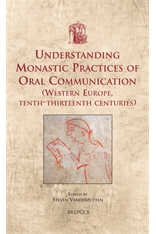 Understanding Monastic Practices of Oral Communication (Western Europe, Tenth-Thirteenth Centuries), ed. Steven Vanderputten (Turnhout, 2011: USML 21), viii+390 pp. ISBN 978-2-503-53482-4.
Understanding Monastic Practices of Oral Communication (Western Europe, Tenth-Thirteenth Centuries), ed. Steven Vanderputten (Turnhout, 2011: USML 21), viii+390 pp. ISBN 978-2-503-53482-4.
Although traditionally defined as a literate environment, Western monastic culture depended on a range of communicative practices which was just as large, and in some ways more sophisticated in its diversity, than that of other groups of society. Monks and nuns exchanged considerable amounts of information for which no written media were deemed necessary or which did not make a complete or immediate transition into written sources. Grouped in five thematic chapters, the papers in this volume aim to provide inroads into a useable interpretation of the various contexts in which monks and nuns in the central Middle Ages considered the spoken word as a vital complementary medium to other forms of communication.
Contents:
Introduction
Steven Vanderputten, “Understanding Monastic Practices of Oral Communication”
Part I: The Politics of Non-Written Communication
Gerd Althoff, “Communication at the Abbey of St. Gall”
Wojtek Jezierski, “Verba volant, scripta manent: Limits of Speech, Power of Silence and Logic of Practice in Some Monastic Conflicts of the High Middle Ages”
Steven Vanderputten, “Monachos hujus ecclesie ad se venire fecit: Attitudes laïques comme reflets des stratégies monastiques orales et rituelles dans les transferts patrimoniaux”
Part II: Traces of Orality in Liturgy, Customs and Material Culture
Susan Boynton, “Oral Transmission of Liturgical Practice in the Eleventh-Century Customaries of Cluny”
Diane J. Reilly, “Education, Liturgy and Practice in Early Cîteaux”
Tjamke Snijders, “Celebrating with Dignity: The Purpose of Benedictine Matins Readings”
Part III: Traces of Orality in the Transmission of Memory
Marie-Anne Polo de Beaulieu, “Traces d’oralité dans les recueils d’exempla cisterciens”
Geoffrey Koziol, “What Charles the Simple Told the Canons of Compiègne: Oral and Written Transmissions of Memory in the Genealogia Dictata a Karolo Rege“
Edina Bozóky, “L’oralité monastique et la fabrication des légendes hagiographiques”
Part IV: Talking Shop: Educating the Monastic Mind
Mirko Breitenstein, “‘Ins Gespräch gebracht’: Der Dialog als Prinzip monastischer Unterweisung”
Albrecht Classen, “Performance, Orality, and Communication in Medieval Women Convents in the Light of the Plays of Hrotsvit of Gandersheim”
Peter Dinzelbacher, “Bericht, Verschriftlichung und Reoralisierung visionärer Erlebnisse im Mönchtum des 12. und 13. Jahrhunderts”
Part V: Talking Shop: Voicing the Monastic Mind
Elisabeth van Houts, “Conversations Amongst Monks and Nuns, 1000-1200”
Julie Barrau, “Did Medieval Monks Actually Speak Latin?”
Wim Verbaal, “Oleum de saxo durissimo: Bernard of Clairvaux’s Poetics of Silence”
Mette B. Bruun, “Wandering Eyes, Muttering, and Frowns: Bernard of Clairvaux and the Communicative Implications of Gesture”
Conclusions
Marco Mostert, “Orality, Non-Written Communication and Monastic Studies”

